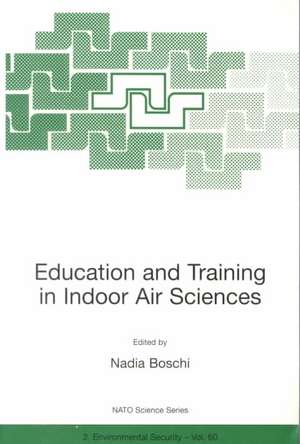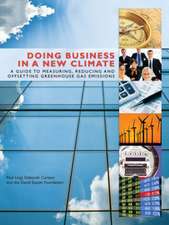Education and Training in Indoor Air Sciences: NATO Science Partnership Subseries: 2, cartea 60
Editat de Nadia Boschien Limba Engleză Paperback – 31 aug 1999
Education and Training in Indoor Air Sciences introduces examples of existing educational programs that seek to bridge the gap between health and building sciences. The contributors - selected among architects, engineers, clinicians, physicists, psychologists and policymakers - discuss the design of a core curriculum for all those holding a degree within building design, construction, operation and maintenance, investigation, and all occupational / environmental health and general practitioners. The book also examines the obstacles to such a curriculum and ways to overcome them.
Din seria NATO Science Partnership Subseries: 2
- 15%
 Preț: 638.43 lei
Preț: 638.43 lei - 5%
 Preț: 1420.29 lei
Preț: 1420.29 lei -
 Preț: 390.84 lei
Preț: 390.84 lei - 18%
 Preț: 949.90 lei
Preț: 949.90 lei -
 Preț: 401.24 lei
Preț: 401.24 lei - 15%
 Preț: 653.14 lei
Preț: 653.14 lei - 5%
 Preț: 1414.64 lei
Preț: 1414.64 lei - 15%
 Preț: 642.18 lei
Preț: 642.18 lei - 18%
 Preț: 1846.40 lei
Preț: 1846.40 lei - 18%
 Preț: 949.90 lei
Preț: 949.90 lei -
 Preț: 380.07 lei
Preț: 380.07 lei - 15%
 Preț: 643.84 lei
Preț: 643.84 lei - 18%
 Preț: 1839.63 lei
Preț: 1839.63 lei -
 Preț: 416.64 lei
Preț: 416.64 lei - 18%
 Preț: 1234.77 lei
Preț: 1234.77 lei - 18%
 Preț: 1834.90 lei
Preț: 1834.90 lei - 18%
 Preț: 950.96 lei
Preț: 950.96 lei - 15%
 Preț: 655.78 lei
Preț: 655.78 lei -
 Preț: 403.53 lei
Preț: 403.53 lei -
 Preț: 381.98 lei
Preț: 381.98 lei - 18%
 Preț: 1836.94 lei
Preț: 1836.94 lei - 15%
 Preț: 645.47 lei
Preț: 645.47 lei - 18%
 Preț: 946.87 lei
Preț: 946.87 lei - 18%
 Preț: 1227.99 lei
Preț: 1227.99 lei - 18%
 Preț: 1232.57 lei
Preț: 1232.57 lei -
 Preț: 398.15 lei
Preț: 398.15 lei - 18%
 Preț: 1232.71 lei
Preț: 1232.71 lei - 18%
 Preț: 1223.88 lei
Preț: 1223.88 lei - 18%
 Preț: 1228.77 lei
Preț: 1228.77 lei
Preț: 386.61 lei
Nou
Puncte Express: 580
Preț estimativ în valută:
73.99€ • 76.96$ • 61.08£
73.99€ • 76.96$ • 61.08£
Carte tipărită la comandă
Livrare economică 14-28 aprilie
Preluare comenzi: 021 569.72.76
Specificații
ISBN-13: 9780792359111
ISBN-10: 0792359119
Pagini: 268
Ilustrații: 268 p. 10 illus.
Dimensiuni: 160 x 240 x 14 mm
Greutate: 0.38 kg
Ediția:Softcover reprint of the original 1st ed. 1999
Editura: SPRINGER NETHERLANDS
Colecția Springer
Seria NATO Science Partnership Subseries: 2
Locul publicării:Dordrecht, Netherlands
ISBN-10: 0792359119
Pagini: 268
Ilustrații: 268 p. 10 illus.
Dimensiuni: 160 x 240 x 14 mm
Greutate: 0.38 kg
Ediția:Softcover reprint of the original 1st ed. 1999
Editura: SPRINGER NETHERLANDS
Colecția Springer
Seria NATO Science Partnership Subseries: 2
Locul publicării:Dordrecht, Netherlands
Public țintă
ResearchCuprins
I. Introduction.- 1. Defming an Educational Framework for Indoor Air Sciences.- II. Historical Perspective: Defining the Scientific Field.- 2. Indoor Air Sciences: A Defined Area of Study or a Field to be Defined.- III. Current trends in Indoor Air Sciences Education.- 3. Toward an Internationally Harmonized, Multiprofessional Educational Program in Indoor Air Sciences: Needs and Strategies.- 4. Trends in the Post Graduate Educational Curriculum of The Indoor Air Sciences.- IV. On-Going Educational Programs.- 5. Indoor Air Science Training and Education in Finland.- 6. Graduate Education and Training in Indoor Air Science - A Canadian Approach.- 7. Indoor Air Fundamentals and Graduate Education in the Czech Republic.- 8. The Teaching of Indoor Air Quality at the Department of Mechanical Engineering at the Technical University of Budapest.- 9. Post Graduate Training on the Health Significance of Indoor Air Quality in Hungary.- 10. Indoor Air Quality Education at the Slovak University of Technology in Bratislava Slovak Republic.- 11. Environmental Engineering Educational Process in the Field of Indoor Air Sciences.- 12. Indoor Air Education in the Slovak Republic: Education at the Medical Faculties.- V. Research and Problem Based Education.- 13. Training Specialists in Occupational Medicine: The Benefits of Research Experience in the Field of Indoor Environment.- 14. Indoor Environmental Quality Research and Education at Harvard University.- 15. Problem Based Teaching in Indoor Air Sciences and Practice. Danish and International Experiences.- 16. The Assessment Techniques of the Indoor Environment: The Case of the Italian University Libraries.- VI. Emerging Issues.- 17. A Sustainable Environment Basis for Education in Indoor Air Sciences.- 18. Engineering Education for Indoor Air Specialists.- 19. Occupant Assessment of Indoor Air Quality.- 20. Knowledge and Technology Transfer in Teaching in Indoor Air Sciences.- VII. Different Educational Players for Different Audiences and Needs.- 21. Federal Roles in Education and Training in the Indoor Air Sciences: Case Studies of U.S. Environmental Protection Agency Involvement in Training Development and Delivery.- 22. Education and Training in the Field of Indoor Air Sciences in Bulgaria.- 23. Education Needs in Eastern European Countries and New Independent States.- 24. Education in Indoor Air Sciences in Poland.- 25. Education in Indoor Air Sciences in Romania.- 26. CIB and Education and Training in Indoor Air Sciences.- 27. Assessment of Indoor Air Quality and its Impact on Children’s Health.- VIII. A Qualitative Methodology for Data Collection.- 28. Focus Group Techniques to Facilitate Group Interaction: Finding A Core Curriculum for Indoor Air Science.- IX. Summary and Conclusions.- 29. New Directions for Education in Indoor Air Sciences: An Interdisciplinary and International Undertaking.- Author index.







